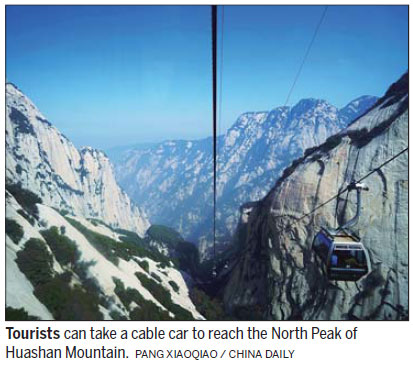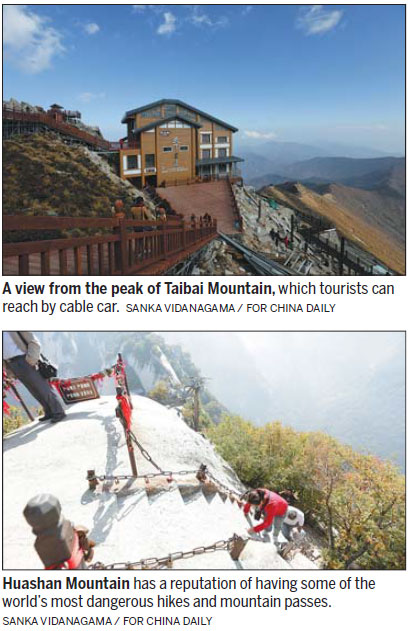Province offers mountains more than museums

Standing on top of Huashan Mountain looking down at the scarily steep cliff drops, it's easy to see why the peak has a reputation as having some of the world's most dangerous hikes and mountain passes.
As the clouds parted, we saw hikers who looked like tiny ants weaving their way up the narrow mountain ridges, stopping to admire the dizzy views and wipe the sweat off their brows.
For a moment, the stunning scenery made me forget how perilous the peaks are, until a group of tourists precariously posed for a selfie and the lump in my throat returned.
We took the cable car up to North Peak, one of five on the mountain, which stands at 1,614 meters high and is also known as Cloud Terrace Peak.
The metal railings, which are all that separated us from the sheer rock face, were adorned with "love locks" left by couples and friends as a token of their visit, just as tourists do on the Pont des Arts bridge in Paris.
Attached to the railings are also red ribbons waving in the breeze, a reminder of Huashan's long history of religious significance as one of the five sacred Taoist mountains in the country.
Huashan was the second mountain we visited in as many days on our Shaanxi trip, the other being Taibai Mountain, which towers 3,750 meters tall and is the highest peak in East China.
In contrast to hot and sunny Huashan, we rented warm coats to bundle up in before heading to the top of Taibai where a bitterly cold breeze blew and very few other visitors stood.
Taibai is home to a huge variety of wildlife, with more than 1,850 plant species and over 1,690 insects and animals, making it particularly popular with bird-watchers and nature lovers.
It's an hourlong drive from the entrance to the cable car that takes visitors to the peak, but far from being boring and we were pleased to find the journey included stops at scenic waterfalls and temples along the way.
Both the mountains boasted striking views that were equally impressive, gave us a fresh perspective on the region and hammered home the fact that Shaanxi has far more than museums to offer.
The mountain visits showed that the province's culture and history is deeply rooted in its landscape and goes beyond the world-famous attractions that tourists arrive in their busloads to see.
Some of our group was impressed by the infrastructure, including cable cars and shuttle buses, which made at least parts of the mountains accessible to all.
While in time this accessibility may bring problems, at Huashan we noted that despite the number of visitors, the area was impressively free of rubbish.
We were told as Shaanxi grows it's looking increasingly toward green, sustainable development so is working to not only open up areas of natural beauty to visitors but to preserve them for years to come.
This sounds like a balancing act that's probably far harder than posing on the peaks for the perfect picture.
clare@chinadaily.com.cn

(China Daily 11/10/2015 page6)














